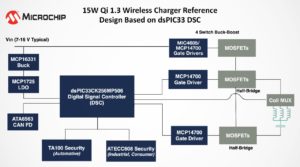The Wireless Power Consortium (WPC) recently released the Qi 1.3 specification that requires authentication for improved safety when transmitting up to 15W of power between a transmitter and a receiver.
To meet the requirements of the specification, Microchip Technology announced a new Qi 1.3 wireless charging reference design that provides developers of wireless charging systems for automotive and consumer applications with the necessary tools and support for the seamless integration and certification of new-generation product designs.
 Microchip’s three-coil Qi 1.3 reference design provides a head start for product development for developers launching certified Qi 1.3 transmitters under tight timelines. The reference design fully integrates secure storage subsystem software with the wireless power microcontroller (MCU) and is a flexible solution, enabling custom topologies and foreign object detection (FOD) implementation.
Microchip’s three-coil Qi 1.3 reference design provides a head start for product development for developers launching certified Qi 1.3 transmitters under tight timelines. The reference design fully integrates secure storage subsystem software with the wireless power microcontroller (MCU) and is a flexible solution, enabling custom topologies and foreign object detection (FOD) implementation.
As a regular member in the Wireless Power Consortium (WPC), which sets global standards for wireless charging of mobile devices, Microchip provided expertise during development of the recently released Qi 1.3 specification. Qi 1.3 is a significant update from Qi 1.2.4 and mandates hardware-based authentication between transmitter and receiving devices for power transfer above 5W.
By adhering to the new authentication standard, designers can ensure phones receiving 15W are receiving it from a Qi-certified authenticated transmitter to ensure safety.
“Wireless charging makes it easy and convenient for consumers to charge devices and, as a result, demand for these systems in the automotive and consumer segments is on the rise,” said Joe Thomsen, VP, MCU16 business unit. “Microchip’s Qi 1.3 reference design, tools and support help engineers to meet rapidly evolving development requirements and enable easy certification of the new Qi 1.3 transmitter designs, speeding time to market and easing end-product certification.”
Included in Microchip’s reference design solution for wireless charging systems are all required elements: Qi controller, Qi application software, provisioned authentication controller that’s a WPC-approved secure storage subsystem and crypto software libraries that execute on the Qi controller.
The reference design includes complete schematics, bill of materials, software and design guidelines. Microchip is partnering with Avnet to make evaluation boards for the Qi reference design available to qualified customers around the world.
To support its Qi 1.3 wireless power solution, Microchip provides the dsPIC33C family of devices to run the Qi application software and the ECC608/TA100 secure storage subsystem provisioned by Microchip as a licensed WPC Manufacturing Certificate Authority.
As a total system solution, this reference design also incorporates MIC4605 and MCP14700 gate drivers, MCP16331 and MCP1725 regulators, an MCP6C02 current sense device, an ATA6563 CAN transceiver, and an MCP9700 temperature sensor.
Filed Under: News, Wireless


Questions related to this article?
👉Ask and discuss on EDAboard.com and Electro-Tech-Online.com forums.
Tell Us What You Think!!
You must be logged in to post a comment.